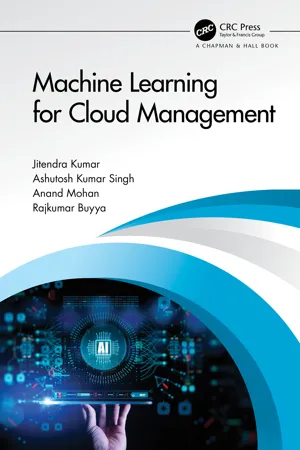
Machine Learning for Cloud Management
Jitendra Kumar, Ashutosh Kumar Singh, Anand Mohan, Rajkumar Buyya
- 182 Seiten
- English
- ePUB (handyfreundlich)
- Über iOS und Android verfügbar
Machine Learning for Cloud Management
Jitendra Kumar, Ashutosh Kumar Singh, Anand Mohan, Rajkumar Buyya
Über dieses Buch
Cloud computing offers subscription-based on-demand services, and it has emerged as the backbone of the computing industry. It has enabled us to share resources among multiple users through virtualization, which creates a virtual instance of a computer system running in an abstracted hardware layer. Unlike early distributed computing models, it offers virtually limitless computing resources through its large scale cloud data centers. It has gained wide popularity over the past few years, with an ever-increasing infrastructure, a number of users, and the amount of hosted data. The large and complex workloads hosted on these data centers introduce many challenges, including resource utilization, power consumption, scalability, and operational cost. Therefore, an effective resource management scheme is essential to achieve operational efficiency with improved elasticity. Machine learning enabled solutions are the best fit to address these issues as they can analyze and learn from the data. Moreover, it brings automation to the solutions, which is an essential factor in dealing with large distributed systems in the cloud paradigm.
Machine Learning for Cloud Management explores cloud resource management through predictive modelling and virtual machine placement. The predictive approaches are developed using regression-based time series analysis and neural network models. The neural network-based models are primarily trained using evolutionary algorithms, and efficient virtual machine placement schemes are developed using multi-objective genetic algorithms.
Key Features:
- The first book to set out a range of machine learning methods for efficient resource management in a large distributed network of clouds.
- Predictive analytics is an integral part of efficient cloud resource management, and this book gives a future research direction to researchers in this domain.
- It is written by leading international researchers.
The book is ideal for researchers who are working in the domain of cloud computing.
Häufig gestellte Fragen
Information
CHAPTER 1 Introduction
1.1Cloud Computing

1.2Cloud Management
Inhaltsverzeichnis
- Cover Page
- Half-Title Page
- Title Page
- Copyright Page
- Dedication Page
- Contents
- List of Figures
- List of Tables
- Preface
- Author
- Abbreviations
- CHAPTER 1 ◾ Introduction
- CHAPTER 2 ◾ Time Series Models
- CHAPTER 3 ◾ Error Preventive Time Series Models
- CHAPTER 4 ◾ Metaheuristic Optimization Algorithms
- CHAPTER 5 ◾ Evolutionary Neural Networks
- CHAPTER 6 ◾ Self Directed Learning
- CHAPTER 7 ◾ Ensemble Learning
- CHAPTER 8 ◾ Load Balancing
- CHAPTER 9 ◾ Summary
- Bibliography
- Index